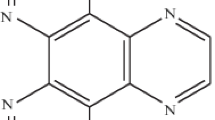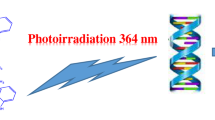Summary
The fluorescent intercalation complex of ethidium bromide with DNA was used as a probe to demonstrate damage in the base-pair region of DNA, due to the action of superoxide radicals. The O ⋅2 − radical itself, generated byγ-radiolysis of oxygenated aqueous Na-formate solutions, is rather ineffective with respect to impairment of DNA. Copper(II) ions, known to interact with DNA by coordinate binding at purines, enhance the damaging effect of O ⋅2 −. Addition of H202 to the DNA/Cu(II) system gives rise to further enhancement, so that DNA impairment by O ⋅2 − becomes comparable to that initiated by⋅OH radicals. These results suggest that the modified, Cu(II)-catalysed, Haber-Weiss process transforms O ⋅2 − into⋅OH radicals directly at the target molecule,
in a “site-specific” mechanism as proposed for other systems (Samuni et al. 1981; Aronovitch et al. 1984). Slow DNA decomposition also occurs withoutγ-irradiation by autocatalysis of DNA/Cu(II)/H202 systems. In this context we observed that Cu(II) in the DNA-Cu2+ complex (unlike free Cu2+) is capable of oxidizing Fe(II) to Fe(III), thus the redox potential of the Cu2+/Cu+ couple appears to be higher than that of the Fe3+/Fe2+ couple when the ions are complexed with DNA.
Metal-catalysed DNA damage by O ⋅-2 also occurs with Fe(III), but not with Ag(I) or Cd(II) ions. It was also observed that Cu(II) ions (but neither Ag(I) nor Cd(II)) efficiently quench the fluorescence of the intercalation complex of ethidium bromide with DNA.
Similar content being viewed by others
References
Aronovitch J, Godinger D, Samuni A, Czapski G (1984) The effect of cell-bound copper on the toxicity of superoxide and vitamin C. In: Bors W, Saran M, Tait D (eds) Oxygen radicals in chemistry and biology. de Gruyter, Berlin (in press)
Beaumont PC, Powers EL (1983) Radiation sensitivity of DNA-metal complexes: A pulse radiolysis study. Int J Radiat Biol 43: 485–494
Bielski BHJ, Shine GG (1979) Reaction rates of superoxide radicals with the essential amino acids. In: Oxygen free radicals and tissue damage. Ciba Foundation Series 65. Elsevier, North Holland. pp 43–56
Bielski BHJ (1983) Evaluation of the reactivities of HO2O ⋅2 with compounds of biological interest. In: Cohen G, Greenwald RA (eds) Oxy radicals and their scavenger systems, vol I. Elsevier, North Holland, pp 1–7
Bjergbakke E (1979) The radiation chemistry of electron- andγ-irradiated aqueous solutions of Fe2+ and CU2+. Nukleonika 24: 825–845
Bloomfield VA, Crothers DM, Tinoco I (1974) In: Physical chemistry of nucleic acids. Harper and Row Publishers, New York, pp 420–429
Cadet J, Teoule R (1978) Comparative study of oxidation of nucleic acid components by hydroxyl radicals, singlet oxygen and superoxide anion radicals. Photochem Photobiol 28: 661–667
Cramp WA (1967) The toxic action on bacteria of irradiated solutions of copper compounds. Radiat Res 30:221–236
Czapski G, Ilan YA (1978) On the generation of the hydroxylation agent from superoxide radical. Can the Haber-Weiss reaction be the source of⋅OH radicals? Photochem Photobiol 28: 651–653
Draganic IG, Draganic ZD (1971) In: The Radiation Chemistry of Water. Physical Chemistry Series Monographs, vol 26. Academic Press, New York, pp 123–168
Eichhorn GL (1973) Complexes of polynucleotides and nucleic acid. In: Eichhorn GL (ed) Inorganic biochemistry, vol 2. Elsevier Scientific Publishing Co., Amsterdam, pp 1210–1243
Ewing D (1983) Radiation sensitization of bacteria and bacterial spores by nitrous oxide and low concentrations of oxygen: evidence for a common mechanism of damage. Int J Radiat Biol 43: 565–569
Fridovich I (1978) Superoxide radicals, superoxide dismutase and aerobic life style. Photochem Photobiol 28: 733–741
Fridovich I (1978) The biology of oxygen radicals. Science 201: 875–880
Goodman J, Hochstein P (1977) Generation of free radicals and lipid peroxidation by redox cycling of adriamycin and daunomycin. Biochem Biophys Res Commun 77:797–803
Greenstock CL (1982) The role of free radicals in radiation and chemical carcinogenesis. Prog React Kinet 11:73–135
Haber F, Weiss J (1934) The catalytic decomposition of hydrogen peroxide by iron salts. Proc R Soc London, Ser A 147: 332–351
Ilan Y, Ilan YA, Czapski G (1978) Do copper ions influence the reduction of ferricytochrome c by O ⋅2 ? Biochim Biophys Acta 503: 399–401
Koppenol WH, Butler J, van Leeuwen JW (1978) The Haber-Weiss cycle. Photochem Photobiol 28: 655–660
Lebkowski JS, Laemmli UK (1982) Evidence for two levels of DNA folding in histone-depleted HeLa interphase nuclei. J Mol Biol 156: 309–324
Misra HP, Fridovich I (1976) Superoxide dismutase and oxygen enhancement of radiation lethality. Arch Biochem Biophys 176: 577–581
NSRDS-NBS Publications: Selected specific rates of reactions of transients from water in aqueous solution. US Government Printing Office, Washington- Anbar M, Bambenek M, Ross AB (1973) I. Hydrated electron. NSRDS-NBS 43- Ross AB (1975) Hydrated electron, supplemental data. NSRDS-NBS 43, supplement- Anbar M, Farhataziz, Ross AB (1975) II. Hydrogen atom. NSRDS-NBS 51- Farhataziz, Ross AB (1977) III. Hydroxyl radical and perhydroxyl radical and their radical ions. NSRDS-NBS 59
Prütz WA (1984) Inhibition of DNA-ethidium bromide intercalation due to free radical attack upon DNA. I. Comparison of the effects of various radicals. Radiat Environ Biophys 23: 1–6
Rabani J, Klug-Roth D, Lilie J (1973) Pulse radiolytic investigation of the catalyzed disproportionation of peroxy radicals. Aqueous cupric ions. J Phys Chem 77: 1169–1175
Rhaese HJ, Freese E (1968) Chemical analysis of DNA alterations. I. Base liberation and backbone breakage of DNA and oligodeoxyadenylic acid induced by hydrogen peroxide and hydroxylamin. Biochim Biophys Acta 155: 476–490
Samuni A, Chevion M, Czapski G (1981) Unusual copper-induced sensitization of the biological damage due to superoxide radicals. J Biol Chem 256: 12632–12635
Schuler RH, Patterson LK, Janata E (1980) Yield for the scavenging of OH radicals in the radiolysis of N20-saturated aqueous solutions. J Phys Chem 84: 2088–2089
Téoule R, Cade J (1978) Radiation-induced degradation of the base component in DNA and related substances - final products. In: Hüttermann J, Köhnlein W, Téoule R (eds) Effects of Ionizing Radiation on DNA. Springer-Verlag, Berlin Heidelberg New York, pp 171–203
Walling C (1975) Fenton's reagent revisited. Accounts Chem Res 8: 125–131
Author information
Authors and Affiliations
Rights and permissions
About this article
Cite this article
Prütz, W.A. Inhibition of DNA-ethidium bromide intercalation due to free radical attack upon DNA. Radiat Environ Biophys 23, 7–18 (1984). https://doi.org/10.1007/BF01326732
Received:
Accepted:
Issue Date:
DOI: https://doi.org/10.1007/BF01326732




